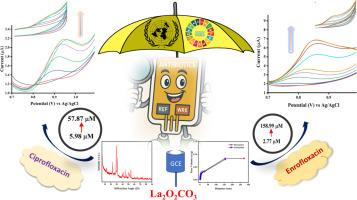基于介孔La2O2CO3纳米结构的可持续性环保电极材料电化学检测恩诺沙星和环丙沙星
IF 3.7
Q1 CHEMISTRY, ANALYTICAL
引用次数: 0
摘要
在现代世界,抗生素的使用对诱发抗菌素耐药性(AMR)构成了严重威胁,这关系到可持续发展目标(sdg)。氟喹诺酮类抗生素,即恩诺沙星和环丙沙星,是破坏“同一个健康”的主要原因。在此背景下,为了提供一种环保和可靠的方法,我们用氧化碳酸镧(La2O2CO3)纳米粒子制作了一种绿色电化学传感器,用于检测几种复杂基质中的恩诺沙星和环丙沙星,这些基质与食品安全、环境监测和人类健康有关。采用绿色合成方法合成碳酸氧材料,同时利用芦笋叶中的植物化学物质发挥还原剂和封盖剂的作用。为了表征合成材料的结晶度和形貌,采用了多种光谱(XRD, BET, EDAX)和微观(FESEM, TEM)技术。用原子力显微镜(AFM)、角形仪和表面轮廓仪对制备的电极进行了表征。所制备的伏安传感器在恩诺沙星和环丙沙星的有效线性范围分别为2.77µM ~ 158.99µM和5.98µM ~ 57.87µM。在这两种情况下,循环伏安法(CV)、差分脉冲伏安法(DPV)和方波伏安法(SWV)都被用作电化学分析技术。恩诺沙星的检出限(LOD)分别为4.07µM、2.91µM和4.98µM,定量限(LOQ)分别为14.2µM、8.83µM和15.1µM。另一方面,环丙沙星在CV、DPV和SWV中的LOQ分别为2.85µM、1.90µM和1.65µM, LOQ分别为8.64µM、5.7µM和5.01µM。本文章由计算机程序翻译,如有差异,请以英文原文为准。

Electrochemical detection of enrofloxacin and ciprofloxacin based on mesoporous La2O2CO3 nanostructures – an eco-friendly electrode material for sustainability
Administration of antibiotics in the modern world has posed a serious threat to induce antimicrobial resistance (AMR), which concerns the Sustainable Development Goals (SDGs). Fluoroquinolone group antibiotics, namely enrofloxacin and ciprofloxacin, are predominantly responsible for undermining the One Health. In this context, to provide an eco-friendly and robust approach, a green electrochemical sensor has been fabricated with lanthanum oxycarbonate (La2O2CO3) nanoparticles for the detection of enrofloxacin and ciprofloxacin in several complex matrices, related to food safety, environmental monitoring, and human health. The green synthesis methodology was adopted for the synthesis of the oxycarbonate material, while the phytochemicals present in the leaves of Sida acuta played the role of reducing and capping agents. To characterize the crystallinity and morphology of the synthesized material, several spectroscopic (XRD, BET, EDAX) and microscopic (FESEM, TEM) techniques were employed. The fabricated electrodes were characterized by atomic force microscopy (AFM), goniometry, and surface profilometry. The fabricated voltammetric sensor demonstrated an efficient linear range of 2.77 µM to 158.99 µM and 5.98 µM to 57.87 µM in the case of enrofloxacin and ciprofloxacin, respectively. In both cases, cyclic voltammetry (CV), differential pulse voltammetry (DPV), and square wave voltammetry (SWV) have been employed as electrochemical analytical techniques. The limit of detection (LOD) was achieved to be 4.07 µM, 2.91 µM, and 4.98 µM, while the limit of quantification (LOQ) was achieved to be 14.2 µM, 8.83 µM, and 15.1 µM in CV, DPV, and SWV, respectively, for the detection of enrofloxacin. On the other hand, the LOD was achieved to be 2.85 µM, 1.90 µM, and 1.65 µM, while the LOQ was found as 8.64 µM, 5.7 µM, and 5.01 µM in CV, DPV, and SWV, respectively, for the detection of ciprofloxacin.
求助全文
通过发布文献求助,成功后即可免费获取论文全文。
去求助

 求助内容:
求助内容: 应助结果提醒方式:
应助结果提醒方式:


